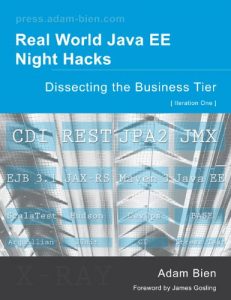The surprisingly successful book Real World Java EE Patterns—Rethinking Best Practices [press.adam-bien.com] discusses the rethinking of legacy J2EE patterns. Now, Real World Java EE Night Hacks walks you through the Java EE 6 best practices and patterns used to create a real world application called “x-ray.” X-ray is a high-performance blog statistics application built with nothing but vanilla Java EE 6 leveraging the synergies between the JAX-RS, EJB 3.1, JPA 2, and CDI 1.0 APIs.
Foreword by James Gosling, Father of Java
Topics covered include:
A brief introduction into the core principles of Java EE 6 (EJB 3.1, CDI, JPA, JTA,Dependency Injection, Convention over Configuration, interceptors, transactions, REST) using real world code
-Unit and integration testing of Java EE 6 applications using JUnit and ScalaTest
-Using interceptors for performance measuring and monitoring
-Creating mocks with Mockito for EJB 3.1, CDI, JPA, and JAX-RS
-Developing embedded integration tests with Arquillian
-Productive use of JAX-RS, Contexts and Dependency Injection, EJB 3.1, and JPA
-RESTful services and REST clients with Java EE 6
-Convention over Configuration with Java EE 6
-Effective component configuration with CDI and Convention over Configuration
-Plug-in implementation with CDI
-Transactional pub/sub without JMS based on CDI and EJB 3.1
-Continuous integration with Maven 3, Mercurial/Git, and Hudson/Jenkins
-Implementing configurable timers and asynchronous batch processing
-Eventual consistency and high-performance deferred writes with Java EE 6
-Real-time client and server monitoring with JMX and REST
-Functional testing with FitNesse
-Performing stress and load tests
-Simplest possible, but maintainable, Java EE 6 design and architecture
Real World Java EE Night Hacks—Dissecting the Business Tier will benefit experienced developers and architects interested in code, not PowerPoint slides :-).
Foreword by James Gosling, Father of Java
Topics covered include:
A brief introduction into the core principles of Java EE 6 (EJB 3.1, CDI, JPA, JTA,Dependency Injection, Convention over Configuration, interceptors, transactions, REST) using real world code
-Unit and integration testing of Java EE 6 applications using JUnit and ScalaTest
-Using interceptors for performance measuring and monitoring
-Creating mocks with Mockito for EJB 3.1, CDI, JPA, and JAX-RS
-Developing embedded integration tests with Arquillian
-Productive use of JAX-RS, Contexts and Dependency Injection, EJB 3.1, and JPA
-RESTful services and REST clients with Java EE 6
-Convention over Configuration with Java EE 6
-Effective component configuration with CDI and Convention over Configuration
-Plug-in implementation with CDI
-Transactional pub/sub without JMS based on CDI and EJB 3.1
-Continuous integration with Maven 3, Mercurial/Git, and Hudson/Jenkins
-Implementing configurable timers and asynchronous batch processing
-Eventual consistency and high-performance deferred writes with Java EE 6
-Real-time client and server monitoring with JMX and REST
-Functional testing with FitNesse
-Performing stress and load tests
-Simplest possible, but maintainable, Java EE 6 design and architecture
Real World Java EE Night Hacks—Dissecting the Business Tier will benefit experienced developers and architects interested in code, not PowerPoint slides :-).






